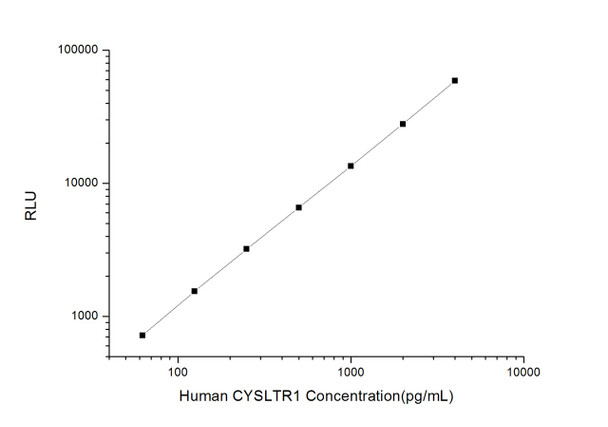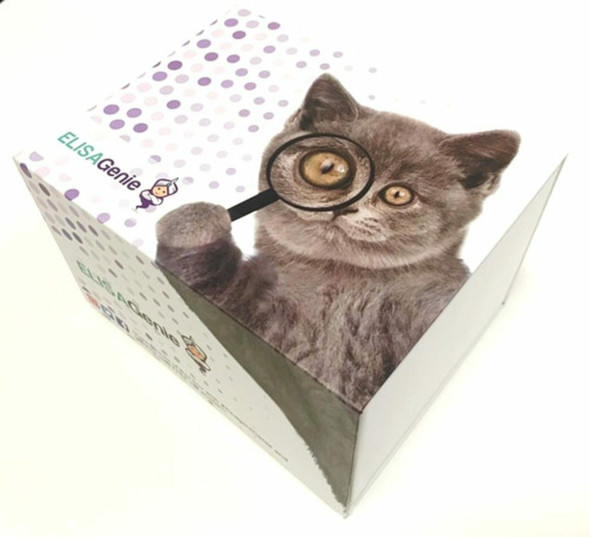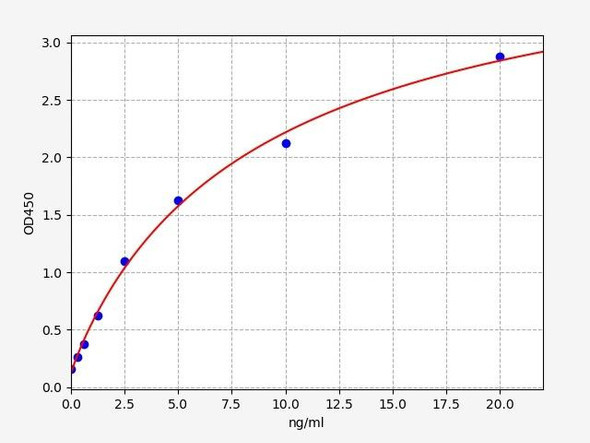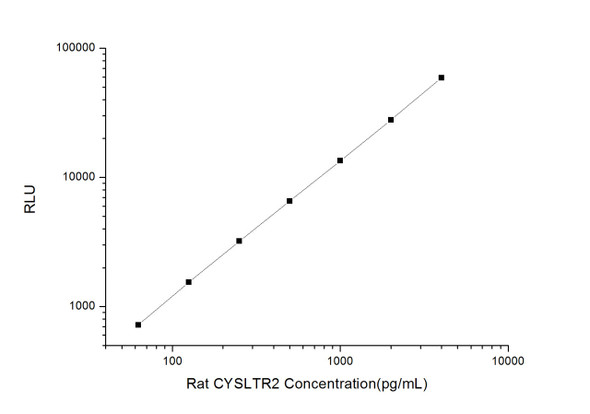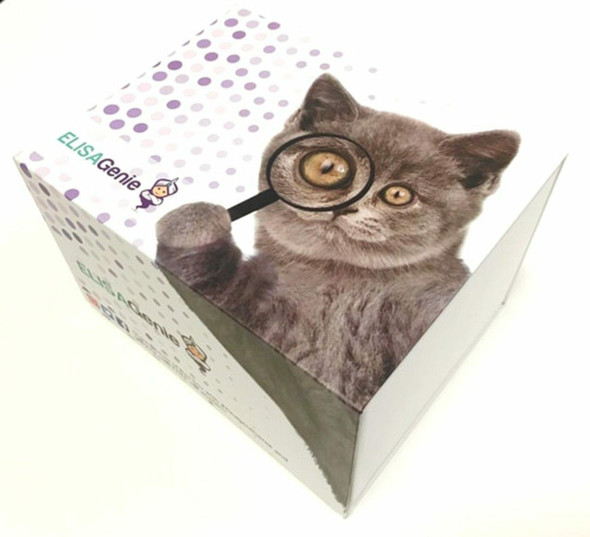Human Neuroscience ELISA Kits
Human CYSLTR1 (Cysteinyl Leukotriene Receptor 1) CLIA Kit (HUES00589)
- SKU:
- HUES00589
- Product Type:
- ELISA Kit
- ELISA Type:
- CLIA Kit
- Size:
- 96 Assays
- Sensitivity:
- 37.5pg/mL
- Range:
- 62.5-4000pg/mL
- ELISA Type:
- Sandwich
- Reactivity:
- Human
- Sample Type:
- Serum, plasma and other biological fluids
- Research Area:
- Neuroscience
Description
| Assay type: | Sandwich |
| Format: | 96T |
| Assay time: | 4.5h |
| Reactivity: | Human |
| Detection method: | Chemiluminescence |
| Detection range: | 62.50-4000 pg/mL |
| Sensitivity: | 37.50 pg/mL |
| Sample volume: | 100µL |
| Sample type: | Serum, plasma and other biological fluids |
| Repeatability: | CV < 15% |
| Specificity: | This kit recognizes Human CYSLTR1 in samples. No significant cross-reactivity or interference between Human CYSLTR1 and analogues was observed. |
This kit uses Sandwich-CLIA as the method. The micro CLIA plate provided in this kit has been pre-coated with an antibody specific to Human CYSLTR1. Standards or samples are added to the appropriate micro CLIA plate wells and combined with the specific antibody. Then a biotinylated detection antibody specific for Human CYSLTR1 and Avidin-Horseradish Peroxidase (HRP) conjugate are added to each micro plate well successively and incubated. Free components are washed away. The substrate solution is added to each well. Only those wells that contain Human CYSLTR1, biotinylated detection antibody and Avidin-HRP conjugate will appear fluorescence. The Relative light unit (RLU) value is measured spectrophotometrically by the Chemiluminescence immunoassay analyzer. The RLU value is positively associated with the concentration of Human CYSLTR1. The concentration of Human CYSLTR1 in the samples can be calculated by comparing the RLU of the samples to the standard curve.
| UniProt Protein Function: | CYSLTR1: Receptor for cysteinyl leukotrienes mediating bronchoconstriction of individuals with and without asthma. Stimulation by LTD4 results in the contraction and proliferation of smooth muscle, edema, eosinophil migration and damage to the mucus layer in the lung. This response is mediated via a G-protein that activates a phosphatidylinositol-calcium second messenger system. The rank order of affinities for the leukotrienes is LTD4 >> LTE4 = LTC4 >> LTB4. Belongs to the G-protein coupled receptor 1 family. |
| UniProt Protein Details: | Protein type:Membrane protein, multi-pass; Receptor, GPCR; Membrane protein, integral; GPCR, family 1 Chromosomal Location of Human Ortholog: Xq13. 2-q21. 1 Cellular Component: membrane; plasma membrane Molecular Function:cysteinyl leukotriene receptor activity; leukotriene receptor activity; peptide receptor activity, G-protein coupled; protein binding Biological Process: circulatory system process; defense response; elevation of cytosolic calcium ion concentration; G-protein signaling, coupled to IP3 second messenger (phospholipase C activating); neuropeptide signaling pathway; respiratory gaseous exchange |
| NCBI Summary: | This gene encodes a member of the G-protein coupled receptor 1 family. The encoded protein is a receptor for cysteinyl leukotrienes, and is involved in mediating bronchoconstriction via activation of a phosphatidylinositol-calcium second messenger system. Activation of the encoded receptor results in contraction and proliferation of bronchial smooth muscle cells, eosinophil migration, and damage to the mucus layer in the lung. Upregulation of this gene is associated with asthma and dysregulation may also be implicated in cancer. Alternative splicing results in multiple transcript variants. [provided by RefSeq, Aug 2013] |
| UniProt Code: | Q9Y271 |
| NCBI GenInfo Identifier: | 20138087 |
| NCBI Gene ID: | 10800 |
| NCBI Accession: | Q9Y271. 1 |
| UniProt Secondary Accession: | Q9Y271,Q5JS94, Q8IV19, B2R954, D3DTE4, |
| UniProt Related Accession: | Q9Y271 |
| Molecular Weight: | 38,541 Da |
| NCBI Full Name: | Cysteinyl leukotriene receptor 1 |
| NCBI Synonym Full Names: | cysteinyl leukotriene receptor 1 |
| NCBI Official Symbol: | CYSLTR1 |
| NCBI Official Synonym Symbols: | CYSLT1; CYSLTR; CYSLT1R; HMTMF81 |
| NCBI Protein Information: | cysteinyl leukotriene receptor 1 |
| UniProt Protein Name: | Cysteinyl leukotriene receptor 1 |
| UniProt Synonym Protein Names: | Cysteinyl leukotriene D4 receptor; LTD4 receptor; G-protein coupled receptor HG55; HMTMF81 |
| Protein Family: | Cysteinyl leukotriene receptor |
| UniProt Gene Name: | CYSLTR1 |
| UniProt Entry Name: | CLTR1_HUMAN |
As the RLU values of the standard curve may vary according to the conditions of the actual assay performance (e. g. operator, pipetting technique, washing technique or temperature effects), the operator should establish a standard curve for each test. Typical standard curve and data is provided below for reference only.
| Concentration (pg/mL) | RLU | Average | Corrected |
| 4000 | 53515 64647 | 59081 | 59046 |
| 2000 | 26305 29413 | 27859 | 27824 |
| 1000 | 14478 12490 | 13484 | 13449 |
| 500 | 6593 6617 | 6605 | 6570 |
| 250 | 3448 3038 | 3243 | 3208 |
| 125 | 1688 1474 | 1581 | 1546 |
| 62.50 | 743 767 | 755 | 720 |
| 0 | 34 36 | 35 | -- |
Precision
Intra-assay Precision (Precision within an assay): 3 samples with low, mid range and high level Human CYSLTR1 were tested 20 times on one plate, respectively.
Inter-assay Precision (Precision between assays): 3 samples with low, mid range and high level Human CYSLTR1 were tested on 3 different plates, 20 replicates in each plate.
| Intra-assay Precision | Inter-assay Precision | |||||
| Sample | 1 | 2 | 3 | 1 | 2 | 3 |
| n | 20 | 20 | 20 | 20 | 20 | 20 |
| Mean (pg/mL) | 198.99 | 549.78 | 1498.68 | 217.06 | 604.00 | 1595.86 |
| Standard deviation | 18.07 | 51.07 | 121.84 | 25.77 | 52.31 | 110.43 |
| C V (%) | 9.08 | 9.29 | 8.13 | 11.87 | 8.66 | 6.92 |
Recovery
The recovery of Human CYSLTR1 spiked at three different levels in samples throughout the range of the assay was evaluated in various matrices.
| Sample Type | Range (%) | Average Recovery (%) |
| Serum (n=5) | 98-116 | 106 |
| EDTA plasma (n=5) | 99-116 | 106 |
| Cell culture media (n=5) | 99-114 | 107 |
Linearity
Samples were spiked with high concentrations of Human CYSLTR1 and diluted with Reference Standard & Sample Diluent to produce samples with values within the range of the assay.
| Serum (n=5) | EDTA plasma (n=5) | Cell culture media (n=5) | ||
| 1:2 | Range (%) | 103-117 | 104-118 | 90-104 |
| Average (%) | 109 | 110 | 95 | |
| 1:4 | Range (%) | 91-104 | 91-109 | 94-109 |
| Average (%) | 98 | 99 | 100 | |
| 1:8 | Range (%) | 100-119 | 93-109 | 95-110 |
| Average (%) | 108 | 100 | 102 | |
| 1:16 | Range (%) | 89-101 | 100-115 | 100-115 |
| Average (%) | 94 | 108 | 108 |
An unopened kit can be stored at 4°C for 1 month. If the kit is not used within 1 month, store the items separately according to the following conditions once the kit is received.
| Item | Specifications | Storage |
| Micro CLIA Plate(Dismountable) | 8 wells ×12 strips | -20°C, 6 months |
| Reference Standard | 2 vials | |
| Concentrated Biotinylated Detection Ab (100×) | 1 vial, 120 µL | |
| Concentrated HRP Conjugate (100×) | 1 vial, 120 µL | -20°C(shading light), 6 months |
| Reference Standard & Sample Diluent | 1 vial, 20 mL | 4°C, 6 months |
| Biotinylated Detection Ab Diluent | 1 vial, 14 mL | |
| HRP Conjugate Diluent | 1 vial, 14 mL | |
| Concentrated Wash Buffer (25×) | 1 vial, 30 mL | |
| Substrate Reagent A | 1 vial, 5 mL | 4°C (shading light) |
| Substrate Reagent B | 1 vial, 5 mL | 4°C (shading light) |
| Plate Sealer | 5 pieces | |
| Product Description | 1 copy | |
| Certificate of Analysis | 1 copy |
- Set standard, test sample and control (zero) wells on the pre-coated plate and record theirpositions. It is recommended to measure each standard and sample in duplicate. Note: addall solutions to the bottom of the plate wells while avoiding contact with the well walls. Ensuresolutions do not foam when adding to the wells.
- Aliquot 100µl of standard solutions into the standard wells.
- Add 100µl of Sample / Standard dilution buffer into the control (zero) well.
- Add 100µl of properly diluted sample (serum, plasma, tissue homogenates and otherbiological fluids. ) into test sample wells.
- Cover the plate with the sealer provided in the kit and incubate for 90 min at 37°C.
- Aspirate the liquid from each well, do not wash. Immediately add 100µL of BiotinylatedDetection Ab working solution to each well. Cover the plate with a plate seal and gently mix. Incubate for 1 hour at 37°C.
- Aspirate or decant the solution from the plate and add 350µL of wash buffer to each welland incubate for 1-2 minutes at room temperature. Aspirate the solution from each well andclap the plate on absorbent filter paper to dry. Repeat this process 3 times. Note: a microplatewasher can be used in this step and other wash steps.
- Add 100µL of HRP Conjugate working solution to each well. Cover with a plate seal andincubate for 30 min at 37°C.
- Aspirate or decant the solution from each well. Repeat the wash process for five times asconducted in step 7.
- Add 100µL of Substrate mixture solution to each well. Cover with a new plate seal andincubate for no more than 5 min at 37°C. Protect the plate from light.
- Determine the RLU value of each well immediately.

